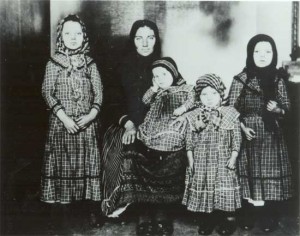For this project based lesson, fourth grade students will have access to their Google Apps for Education accounts and will use Google Chromebooks to access and research lesson materials. The estimated time for this Immigration Project is two weeks with with tasks to be completed in and out of the classroom.
Initially provide a brief reintroduction on immigration using Google Earth to visually highlight scope of mass immigration using interactive white board. Showcasing routes people from Germany, Ireland, France, Britain and China used to immigrate to the United States over the course of nearly 100-years through the 1920’s.
Zoom in on major ports used in Europe in the 1900’s (Cherbourg, France, Liverpool and London, England, Bremen and Hamburg, Germany) to depart for the New World and where they arrived in the United States (Boston, New York, Philadelphia, Baltimore, Galveston and San Francisco).
Google Maps
Pose the main question students are seeking during his project based lesson on immigration, “Why did people from across the world immigrate to the United States and further, why do they continue to do so now?” Allow a few minutes for student ‘turn and talk’ to discuss their answers. Request responses from students and discuss project and its scope. Letters will be written for an audience on the internet, posted to the school webpage to be shared with the school community.
After time for responses, introduce discussion with students about their own ancestry. Show a world map with the interactive white board and encourage students who know what country their family immigrated from, place markers on the map.
Make a list of what students should know and understand after this lesson. At this point share some example ideas for completion of the lesson personally and as a group. Explain the group aspect as well as a classroom blogging aspect.
Questions to pose:
- What rights did the immigrants receive when they became citizens?
- How might that differ from where they came from?
- Did immigrants come to the United States from opportunities that were not available in their native land? Why?
These questions will be available throughout as a guide, posted on the classroom blog.
Allow students ample time to gather information using resources available online or in the classroom. What does this look like? Students can have time to research online using:
- ellisisland.org
- geneology.com
- youtube.com
- Google Maps
- interviewing grandparents
- student ideas
Students will create a Google Doc, properly name the document and share with their 3-4 group members and their teacher. (Could use a script like Doctopus to share project with student as well) This will be the group document allowing for collaboration and peer review before the final is passed in and presented. Teacher will share out classroom blog (using Blogger) with correct permissions for students to interact with each other and make posts. This blogging area will serve as a place for students to interact with each other with questions relating to the assignment as well as an official
 Students write letters as immigrants back to their families discussing what the trip and experience has been so far. Example: If student is contacting family back in Ireland, what part of the country are you writing from? What year could this have happened? What are some unique issues Irish immigrants faced? Where did you leave from and what port did you arrive in? How would this letter look? Is it a formal letter or informal letter? What is something to include in a letter to your family to show them how the new world looks? Thoughts should be gathered in Google Docs, but the final letter should be hand written or typed depending on the year. (Photo: Family arriving at Ellis Island. Credit: ellisisland.org)
Students write letters as immigrants back to their families discussing what the trip and experience has been so far. Example: If student is contacting family back in Ireland, what part of the country are you writing from? What year could this have happened? What are some unique issues Irish immigrants faced? Where did you leave from and what port did you arrive in? How would this letter look? Is it a formal letter or informal letter? What is something to include in a letter to your family to show them how the new world looks? Thoughts should be gathered in Google Docs, but the final letter should be hand written or typed depending on the year. (Photo: Family arriving at Ellis Island. Credit: ellisisland.org)
Another idea I read about recently is to post a world map and track the origin of words. This would tie to word study, and the classes could track culturally relevant words from various parts of the world.
Throughout the time spent on the project based lesson, students will combine old and new by using a blog to post their thoughts, anxieties, ideas and experiences as they depart, travel and arrive in the New World as if it was the early 1900’s.
At the conclusion of completing a letter as a group, commenting and posting individual thoughts on the blog, students will gather back into their groups to present what they have learned via a brief presentation to peers on their findings.
Project Based Lesson Rubric
Using the criteria below on a scale of 1 to 4, students will receive their final grade. (1 = Emerging, 2 = Developing, 3 = Proficient, 4 = Exemplary)
- Produce clear, organized letter
- Use proper resources and cited work
- Write thorough blog posts
- Provide feedback to peers posts
- Individual productivity as a member of a group
- Display appropriate and productive behavior
- Use technology appropriately throughout
- Use Google Docs appropriately throughout
Massachusetts Frameworks: Civics and Government
4. Give examples of the major rights that immigrants have acquired as citizens of the United States (e.g., the right to vote, and freedom of religion, speech, assembly, and petition). (C)
5. Give examples of the different ways immigrants can become citizens of the United States. (C)
4.14 Identify the five different European countries (France, Spain, England, Russia, and the Netherlands) that influenced different regions of the present United States at the time the New World was being explored and describe how their influence can be traced to place names, architectural features, and language. (H, G)
4.16 Identify major immigrant groups that live in Massachusetts and where they now live in large numbers (e.g., English, Irish, Italians, French Canadians, Armenians, Greeks, Portuguese, Haitians, and Vietnamese). (H, G)
Common Core State Standards – ELA/Literacy
SL.4.1. Engage effectively in a range of collaborative discussions (one-on-one, in groups, and teacher-led) with diverse partners on grade 4 topics and texts, building on others’ ideas and expressing their own clearly.
SL.4.2. Paraphrase portions of a text read aloud or information presented in diverse media and formats, including visually, quantitatively, and orally.
SL.4.4. Report on a topic or text, tell a story, or recount an experience in an organized manner, using appropriate facts and relevant, descriptive details to support main ideas or themes; speak clearly at an understandable pace.
SL.4.5. Add audio recordings and visual displays to presentations when appropriate to enhance the development of main ideas or themes.
SL.4.6. Differentiate between contexts that call for formal English (e.g., presenting ideas) and situations where informal discourse is appropriate (e.g., small-group discussion); use formal English when appropriate to task and situation. (See grade 4 Language standards 1 here for specific expectations.)
RI.4.1. Refer to details and examples in a text when explaining what the text says explicitly and when drawing inferences from the text.
RI.4.2. Determine the main idea of a text and explain how it is supported by key details; summarize the text.
RI.4.3. Explain events, procedures, ideas, or concepts in a historical, scientific, or technical text, including what happened and why, based on specific information in the text.
Craft and Structure
RI.4.4. Determine the meaning of general academic and domain-specific words or phrases in a text relevant to a grade 4 topic or subject area.
RI.4.7. Interpret information presented visually, orally, or quantitatively (e.g., in charts, graphs, diagrams, time lines, animations, or interactive elements on Web pages) and explain how the information contributes to an understanding of the text in which it appears.
RI.4.9. Integrate information from two texts on the same topic in order to write or speak about the subject knowledgeably.
W.4. Produce clear and coherent writing in which the development, organization, and style are appropriate to task, purpose, and audience.
W.5. Develop and strengthen writing as needed by planning, revising, editing, rewriting, or trying a new approach.
W.6. Use technology, including the Internet, to produce and publish writing and to interact and collaborate with others.
